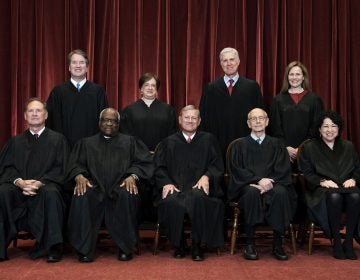‘It is inadequate’: Delaware launches new effort to diversify judges and lawyers
Delaware’s first Black Supreme Court justice joins an effort to improve diversity among the state’s judiciary.

Delaware Supreme Court Chief Justice Collins J. Seitz Jr. and Justice Tamika R. Montgomery-Reeves talk with WHYY News about a new effort to improve diversity in the state's courts. (Screengrab via Zoom)
When Tamika R. Montgomery-Reeves was sworn in as associate justice on the Delaware Supreme Court in January 2020, she made history as the first Black judge to join the state’s top court.
The rarity of her accomplishment is the result of a lack of diversity throughout Delaware’s judiciary. According to the state, 75% of its judicial officers are white, which is about 6% higher than the percentage of white residents in the state.
But the higher up the judicial ladder you go, racial diversity drops.
The state’s Justice of the Peace Court, which is responsible for bail decisions for most defendants, is 65% white, while the state’s top business panel, the Court of Chancery, is 100% white. With last year’s addition of Montgomery-Reeves, the Supreme Court is 80% white.
“It is inadequate,” Supreme Court Chief Justice Collins J. Seitz Jr. said of the state court’s racial diversity in an interview with WHYY News. “It’s not where we want it to be. It’s been an issue for a long time that needed to be addressed.”
Seitz is now joining Justice Montgomery-Reeves in a project to improve diversity among both judges and the lawyers who argue cases before them.
“Take a look at the makeup of the citizens in our state. … That’s what I think our bench should look like,” Montgomery-Reeves told WHYY. “I think that’s important.”
The Delaware Bench and Bar Diversity Project, led by Seitz and Montgomery-Reeves, will create a steering committee including members of the Department of Justice, the Office of Defensive Services, the Governor’s Office, the Delaware State Bar Association, Delaware Law School, Delaware State University, the University of Delaware, and nonprofit legal aid groups. The committee will study the issue of racial disparity in the courts and report back with recommendations by the end of the year.
“Success, in my view, looks like a bench that is more representative of the community that we serve,” Montgomery-Reeves said. “It’s my hope, as the chief justice said, that I won’t be in rooms anymore where I’m the only person of color or one of very few, where I can count on one hand or two the number of attorneys of color who are practicing.”
The justices hope the effort to diversify the courts will be a national model other states can adapt to their unique circumstances.
In Delaware, the governor appoints judges after getting recommendations from the 12-member judicial nominating committee, 11 of whom are appointed by the governor. The appointee must then be approved by the state Senate. The recommendations come from members of the state’s bar, so increasing diversity among lawyers in Delaware should eventually create a more diverse pool of candidates for the governor to pick from.
“I know if you talk to Governor Carney, he would say, ‘I want to do my very best to make this a representative bench. But unless I have diverse candidates that are coming through the judicial nominating commission and that are recommended to me that I can recommend to the General Assembly for confirmation, my hands are tied,’” Seitz said.
The project will get help from the National Center for State Courts, a group that helps local courts with strategic planning, diversity and community engagement, and justice system reform. The state will also team up with the AccessLex Institute, a West Chester-based nonprofit linking more than 200 law schools around the country.
Seitz said AccessLex will help the state connect with students as early as high school and create a pipeline for them to go to law school and “have some kind of guarantee where they would be placed with the Delaware employer, Delaware law firm, with a government entity or somebody else in-house … and hopefully put down roots here as a lawyer for those schools, and having a rich, enriching career of being a lawyer here in Delaware.”
“I’m so excited about this collaboration and the fact that our goal is to build and sustain a more diverse bench and bar,” Montgomery-Reeves said. “I really think our state and our country are primed and ready to tackle issues of diversity, equity and inclusion on a number of fronts.”
The lack of Black judges is especially egregious considering Black Delawareans are over-represented in the criminal justice system. A 2016 study of Delaware courts by the University of Pennsylvania found that even though Black people make up 22% of the state’s population, they account for 42% of those arrested, 42% of criminal dispositions, 51% of incarceration sentences, and 57% of Delaware’s incarcerated population.
That five-year-old report called for criminal justice reform “to reduce racial disparities in incarceration.”
The issue of diversity within Delaware’s judiciary has drawn attention from Rev. Al Sharpton, who has appeared in the state on behalf of the lobbying group Citizens for a Pro-Business Delaware. The group formed after members were unhappy with a Chancery Court ruling ordering the sale of the multimillion-dollar language services company TransPerfect.
Since the ruling, Citizens for a Pro-Business Delaware has shifted its focus from protesting Chancery Court’s handling of that case and is now raising awareness about diversity in the courts.
“I don’t care who got a grudge against who, the facts mean they need to deal with diversity on the bench in this state,” Sharpton said in an appearance for the group last year. “I’m going to keep coming until we see diversity at the judicial level. We can set a national tone by dealing with it in this state.”
Last year, Rev. Dale Dennis of Hoyt Memorial CME Church in Wilmington led a rally in front of Legislative Hall in Dover to make a similar call.
“We’re calling for diversity in our court systems, it is absolutely essential that the courts of Delaware begin to look like the people of Delaware,” Hoyt said. “It’s essential that we begin to represent our entire community, and not just a select few.”
Seitz said the activity by Sharpton and others did not play a role in the launch of this project.
“It has been my Number One priority since the day I took office, and will continue to be my Number One priority after we get through it,” Seitz said.
The project was unveiled the same day Seitz took part in a ceremony honoring the 64th anniversary of the Brown v. Board of Education decision that found racial segregation in public schools unconstitutional. Seitz’s father, Judge Collins J. Seitz, found segregated schools were discriminatory in his ruling on the Gebhart v. Belton case, one of two Delaware cases that combined into the U.S. Supreme Court’s Brown v. Board of Education ruling.
“If you know anything about the history of my family, you know it’s in my genes, and it is something that I charged my staff with from Day One, to start working on the diversity issues,” he said.
Delaware’s lack of judicial diversity reflects the trend on top courts around the country. According to the Brennan Center for Justice, white men account for 55% of state Supreme Court justices, even though they make up just 30% of the national population. Just 8% of state Supreme Court justices nationwide are Black men, while Black women make up just 7% of top U.S. court seats.
There are no Black justices in 28 states, no Latino justices in 40 states, and no Asian justices in 44 states, according to the same report.

Get daily updates from WHYY News!
WHYY is your source for fact-based, in-depth journalism and information. As a nonprofit organization, we rely on financial support from readers like you. Please give today.







